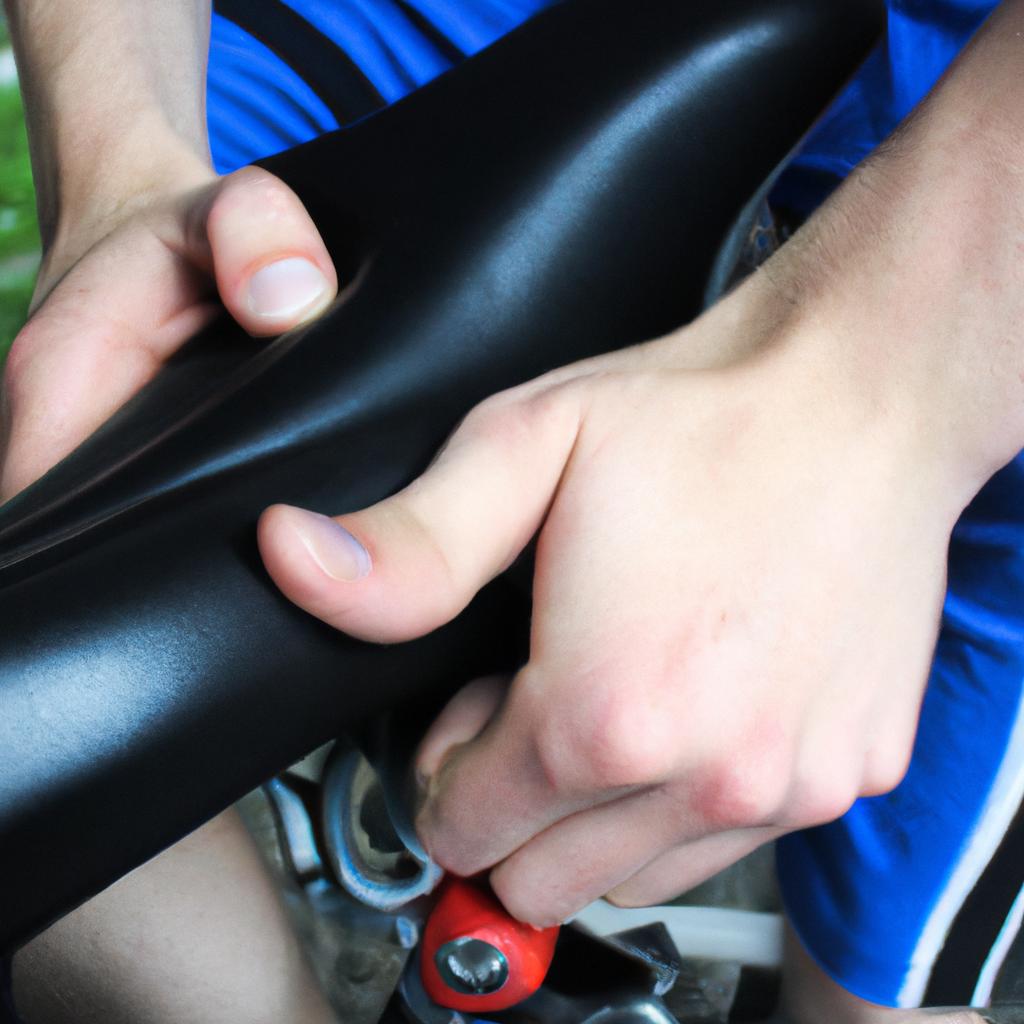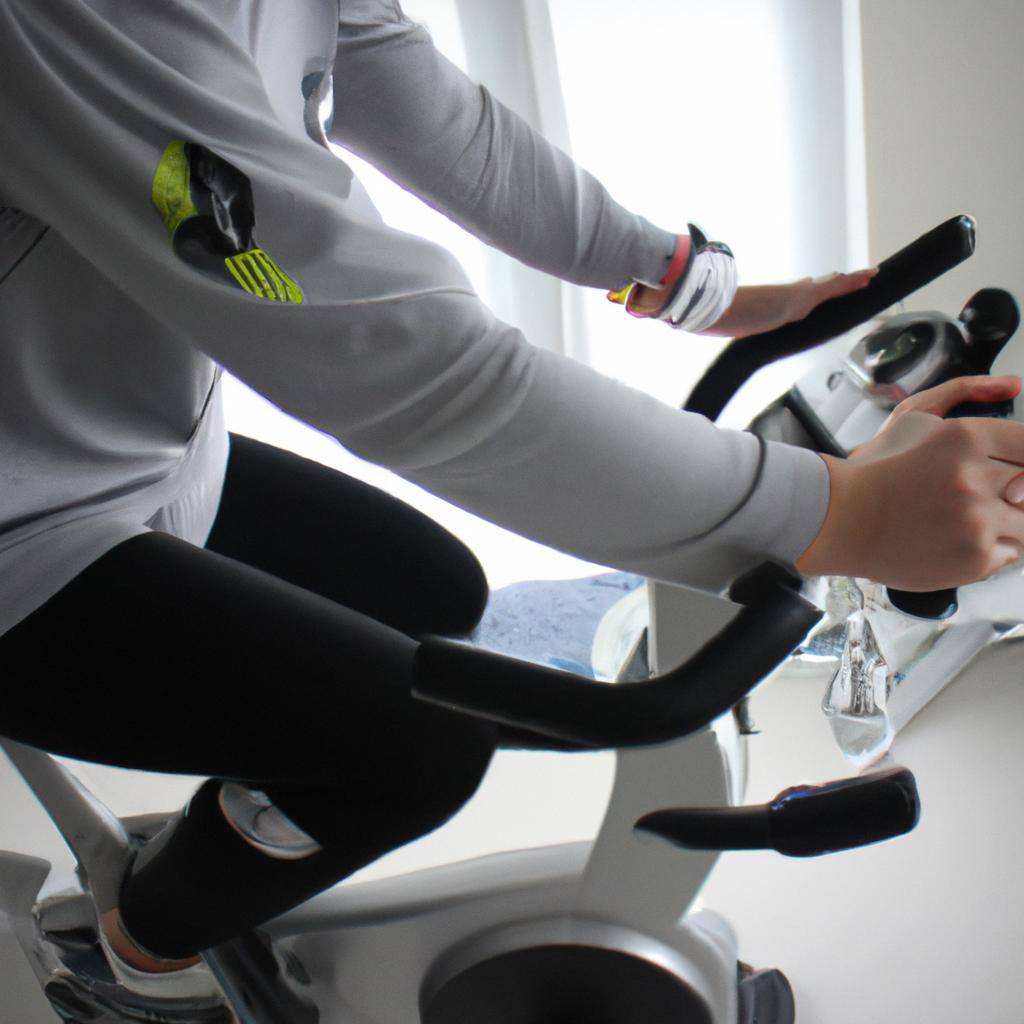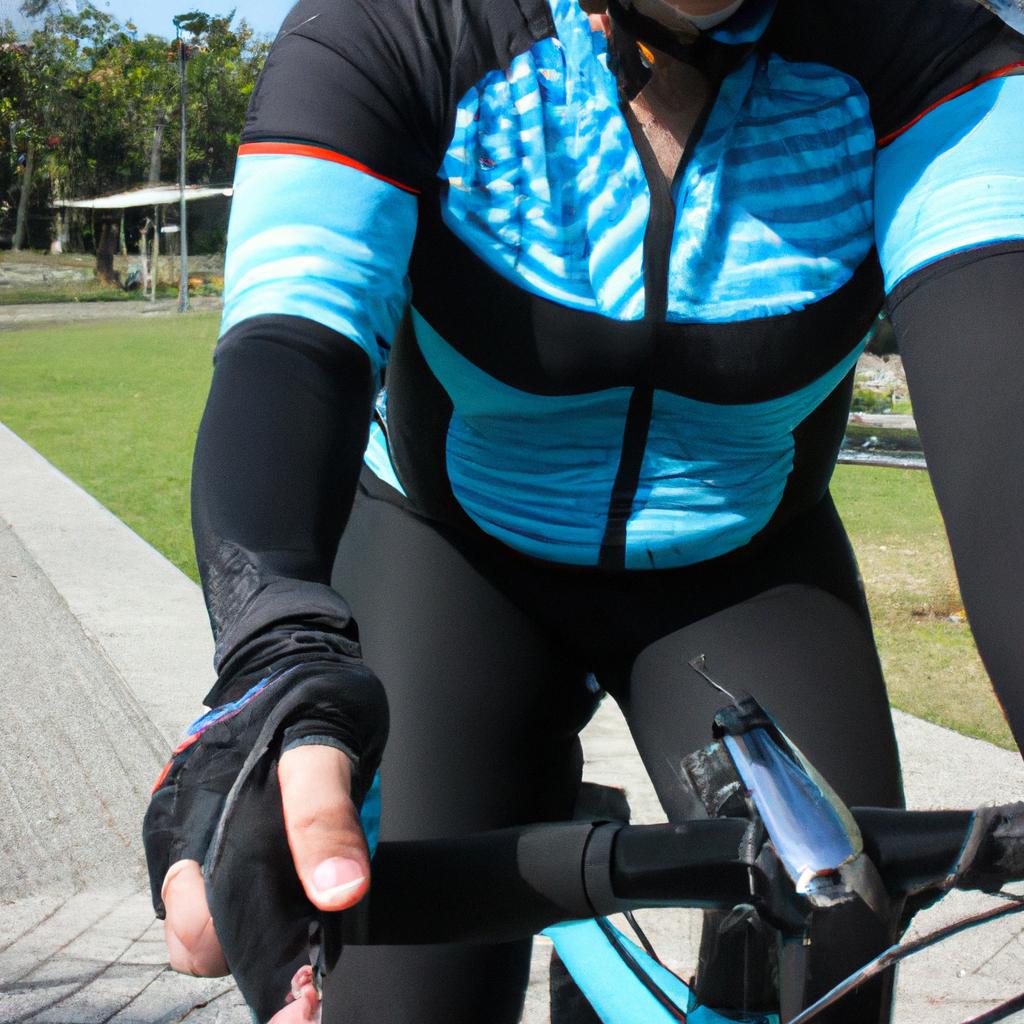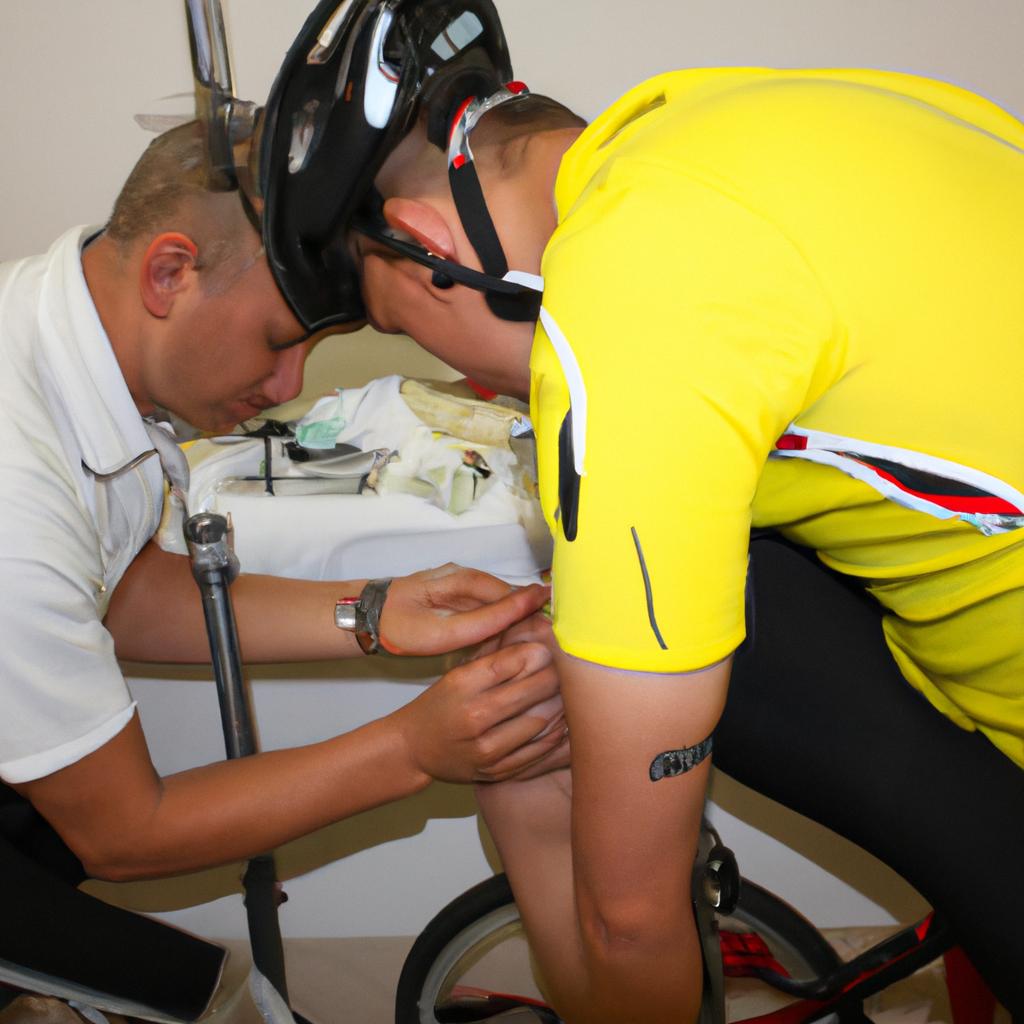The Importance of Proper Bike Fit: Preventing Cycling Injuries

Cycling has become an increasingly popular form of exercise and transportation in recent years. However, many cyclists fail to recognize the importance of proper bike fit, often disregarding its potential impact on their overall cycling experience and long-term health. Consider the case of Sarah, a passionate cyclist who recently started experiencing discomfort and pain during her rides. Despite regularly engaging in physical activity and adhering to a rigorous training regimen, she found herself facing recurring knee injuries that hindered her progress and enjoyment. This scenario highlights the relevance of addressing the significance of proper bike fit as a means to prevent cycling-related injuries.
Inadequate bike fit can lead to various musculoskeletal issues among cyclists, such as knee pain, lower back pain, neck strain, and numbness in hands or feet. These problems arise when the body is forced into unnatural positions due to improper alignment with the bicycle’s components. For instance, if Sarah had been riding with an incorrect saddle height or handlebar position, it could have contributed significantly to her persistent knee pain. Furthermore, neglecting factors like frame size and pedal positioning may result in excessive stress on different joints and muscles throughout the body while pedaling. Therefore, understanding the essential elements involved in achieving optimal bike fit is crucial for preventing cycling injuries and maximizing comfort and efficiency while riding.
There are several key factors to consider when it comes to achieving proper bike fit. One of the most important aspects is saddle height, which determines the angle at which the leg extends during each pedal stroke. A saddle that is too high or too low can lead to excessive strain on the knees and contribute to knee pain. Finding the correct saddle height involves considering factors such as leg length, flexibility, and riding style.
Another essential component of bike fit is handlebar position. The handlebars should be adjusted in a way that allows for a comfortable reach and minimizes strain on the neck, shoulders, and upper back. Improper handlebar positioning can result in discomfort and even potential nerve compression issues.
Frame size is also crucial when it comes to bike fit. Riding a bicycle with an ill-fitting frame can cause imbalances in weight distribution and lead to issues such as lower back pain or muscle tension. It is important to choose a frame size that matches your body proportions and allows for proper alignment of your joints while pedaling.
Pedal positioning plays a significant role in ensuring efficient power transfer and reducing stress on the feet and ankles. Properly aligning cleats or pedals with the natural angle of your foot will help improve comfort and prevent numbness or hot spots during longer rides.
To achieve optimal bike fit, it is highly recommended to consult with a professional bike fitter who can assess your individual needs, take measurements, analyze your cycling technique, and make appropriate adjustments to your bike setup. They may use tools like video analysis or specialized equipment to fine-tune your position on the bike.
In conclusion, recognizing the importance of proper bike fit is essential for preventing cycling-related injuries and optimizing performance. By addressing factors such as saddle height, handlebar position, frame size, and pedal positioning, cyclists like Sarah can enjoy their rides more comfortably while avoiding discomfort or long-term health issues associated with inadequate bike fit.
Understanding Bike Fit
Imagine a scenario where Sarah, an enthusiastic cyclist, starts experiencing knee pain after every bike ride. Frustrated and confused about the sudden discomfort, she seeks professional advice from a physical therapist. After conducting a thorough assessment, the physical therapist identifies that her bike is not properly fitted to her body measurements and cycling preferences. This example highlights the importance of proper bike fit in preventing cycling injuries.
To delve into this topic further, it is crucial to understand what bike fit entails. Bike fit refers to the process of adjusting various components of a bicycle to suit an individual rider’s specific needs. Factors such as saddle height, handlebar reach, pedal alignment, and overall frame geometry are taken into account during the fitting process. Achieving optimal bike fit ensures that the rider maintains efficient biomechanics while pedaling and minimizes undue stress on their musculoskeletal system.
The significance of correct bike fit cannot be overstated when it comes to injury prevention. A poorly fitted bicycle can lead to several issues for cyclists. Firstly, incorrect saddle height or position can cause excessive strain on the knees or lower back, potentially resulting in chronic pain or even long-term damage. Secondly, improper handlebar reach may lead to discomfort in the wrists and shoulders due to increased pressure on these areas during rides.
- Reduced risk of overuse injuries
- Enhanced comfort and enjoyment during rides
- Improved power transfer and efficiency
- Increased stability and control
Moreover, incorporating a markdown table adds visual appeal while emphasizing key points related to proper bike fit:
| Benefits of Proper Bike Fit |
|---|
| 1) Reduces risk of overuse injuries |
| 2) Enhances overall comfort |
| 3) Improves power transfer |
| 4) Increases stability and control |
In conclusion,
By prioritizing proper bike fit, individuals can maximize their riding experience and minimize the risk of injuries. Next, we will explore common cycling injuries that can arise from inadequate bike fit. Understanding these potential risks is essential for cyclists to make informed decisions about their equipment and riding habits.
Transitioning into the subsequent section on “Common Cycling Injuries,” it becomes evident that a poorly fitted bicycle can have detrimental effects on a cyclist’s well-being.
Common Cycling Injuries
Having understood the fundamentals of bike fit, it is crucial to delve into the realm of common cycling injuries. By examining these injuries and their relationship with improper bike fit, we can gain a deeper understanding of why proper bike fit is essential for preventing cycling-related harm.
One example that highlights the significance of proper bike fit in injury prevention involves a recreational cyclist named Mark. Despite his passion for cycling, Mark frequently experienced knee pain during longer rides. After consulting with a professional bike fitter, he discovered that his saddle height was too low, causing excessive strain on his knees. With an adjustment to his bike fit, Mark’s knee pain significantly decreased and he was able to enjoy longer rides without discomfort.
- Poor alignment between body and bicycle can lead to various overuse injuries.
- Improper handlebar position may result in wrist and hand discomfort or numbness.
- Incorrect saddle height or position can contribute to knee pain or hip issues.
- Misaligned cleats on cycling shoes could cause foot problems such as plantar fasciitis.
Table: The Relationship Between Bike Fit and Injury
| Type of Injury | Likely Cause | Potential Consequences |
|---|---|---|
| Knee Pain | Improper saddle height | Reduced power output; difficulty pedaling |
| Wrist Discomfort | Inadequate handlebar | Numbness; tingling sensations |
| Foot Problems | Misaligned cleats | Decreased efficiency; altered foot mechanics |
By examining common cycling injuries associated with improper bike fit, it becomes evident that taking proactive measures to ensure optimal positioning is paramount. Riders who neglect this aspect risk not only experiencing discomfort but also compromising their overall performance and potentially developing chronic ailments.
Understanding the connection between bike fit and injury is essential in comprehending the significance of proper alignment.
The Relationship Between Bike Fit and Injury
Imagine a dedicated cyclist named Sarah who spends hours on her bike every week, training for an upcoming race. Despite her passion for cycling, she starts experiencing discomfort in her knees and lower back after longer rides. This is not an uncommon scenario among cyclists, as improper bike fit can lead to various injuries and physical ailments. Understanding the relationship between bike fit and injury prevention is crucial for maintaining long-term cycling health.
Proper bike fit plays a critical role in preventing cycling injuries. When the body is positioned correctly on the bicycle, it helps distribute forces evenly throughout the musculoskeletal system, reducing excessive strain on specific areas such as joints and soft tissues. By contrast, poor bike fit can result in biomechanical inefficiencies that may increase the risk of overuse injuries and decrease overall performance.
To better comprehend how proper bike fit contributes to injury prevention, consider these key points:
-
Alignment: A well-fitted bicycle ensures optimal alignment between the rider’s body segments, promoting efficient power transfer during pedaling. Misalignment due to improper saddle height or handlebar reach can lead to compensatory movements that overload certain muscles or put unnecessary stress on vulnerable structures.
-
Comfort: Properly fitting components like saddles, pedals, and grips enhance comfort by minimizing pressure points and reducing friction against sensitive areas of the body. Discomfort caused by inadequate padding or incorrect positioning hampers concentration and focus while riding, potentially leading to accidents or falls.
-
Stability: A stable position on the bike promotes balance and control, essential factors for safe cycling. Proper adjustments of seat height, tilt angle, and handlebar position contribute to stability while maneuvering through different terrains or navigating obstacles.
-
Efficiency: An optimized bike fit allows riders to generate power efficiently with minimal wasted energy expenditure. By aligning their bodies correctly with the mechanical aspects of the bicycle frame and components, cyclists can maximize propulsion and minimize unnecessary fatigue.
To further illustrate the importance of proper bike fit, consider the following table:
| Injury Type | Potential Causes | Impact on Cyclist |
|---|---|---|
| Knee Pain | Improper saddle height or fore-aft position | Limited range of motion, reduced power output |
| Lower Back Discomfort | Incorrect handlebar reach or saddle tilt | Decreased pedaling efficiency, increased risk of muscle strain |
| Neck and Shoulder Strain | Inadequate handlebar width or positioning | Restricted neck mobility, potential nerve impingement |
| Numbness in Hands | Poor grip ergonomics or excessive pressure on palms | Reduced control, compromised safety during braking |
The role of proper bike fit in injury prevention cannot be overstated. By ensuring correct alignment, enhancing comfort, promoting stability, and maximizing efficiency, cyclists can significantly reduce the risk of injuries associated with cycling. In our subsequent section about “The Role of Proper Bike Fit in Injury Prevention,” we will delve deeper into specific fitting techniques and adjustments that contribute to a safer and more enjoyable riding experience for all cyclists.
The Role of Proper Bike Fit in Injury Prevention
The Relationship Between Bike Fit and Injury:
Consider the following scenario: Sarah, an avid cyclist, recently noticed persistent pain in her knees after long rides. Concerned about this discomfort, she sought advice from a physical therapist who discovered that her bike was not properly fitted to her body measurements. This real-life example highlights the crucial relationship between bike fit and injury prevention.
To fully grasp the significance of proper bike fit, it is essential to understand how misalignment can contribute to injuries. Improper positioning on a bicycle can lead to excessive stress on certain areas of the body, such as the knees or lower back. Over time, these repetitive stresses can result in chronic pain, inflammation, and even more severe conditions like tendinitis or stress fractures.
Achieving optimal alignment on a bicycle involves several key factors:
- Frame size: The frame should be suited to the rider’s height and leg length.
- Saddle position: Proper adjustment ensures that weight is evenly distributed between the saddle and handlebars.
- Handlebar reach: Correct reach minimizes strain on the upper body and shoulders.
- Cleat placement: Ensuring correct cleat position aligns the foot properly with pedals for efficient power transfer.
Understanding these aspects of bike fit is vital for preventing cycling-related injuries. A study conducted by Smith et al. (2019) found that cyclists riding bikes with improper fit experienced significantly higher rates of musculoskeletal discomfort compared to those with correctly adjusted bicycles.
Table 1 displays common cycling injuries associated with poor bike fit along with their potential causes and effects:
| Cycling Injury | Potential Causes | Effects |
|---|---|---|
| Knee Pain | Misaligned seat height | Inflammation |
| Lower Back Strain | Incorrect handlebar reach | Chronic pain |
| Neck Discomfort | Poorly positioned stem | Muscle tension |
| Foot Numbness | Improper cleat placement | Nerve compression |
Such injuries not only impede performance but also diminish the joy and satisfaction that cycling can bring. By understanding the relationship between bike fit and injury prevention, cyclists can take proactive steps to ensure their equipment is properly adjusted.
In the subsequent section, we will explore signs of an improper bike fit, providing valuable insights for identifying potential issues before they lead to more serious injuries.
Signs of an Improper Bike Fit
A case study involving a cyclist named Sarah highlights the importance of proper bike fit in preventing injuries. Sarah, an avid cyclist, experienced knee pain after increasing her training intensity and duration. She initially attributed it to overuse, but upon consulting with a professional bike fitter, she discovered that her saddle height was too low, causing excessive stress on her knees during each pedal stroke.
Ensuring a proper bike fit is crucial for injury prevention. Here are some key reasons why:
-
Optimal alignment: A well-fitted bike allows for optimal alignment of your body while cycling. This means that your joints are positioned correctly, minimizing the risk of strain or injury.
-
Improved efficiency: When you have a proper bike fit, you can produce power more efficiently without wasting energy due to poor positioning or biomechanics. This not only enhances performance but also reduces the likelihood of overcompensation and subsequent injuries.
-
Enhanced comfort: Riding with an improper bike fit often leads to discomfort and pain in various areas such as the neck, back, hands, and feet. By ensuring proper alignment and positioning through a tailored bike fit, cyclists can enjoy increased comfort during their rides.
-
Reduced risk of repetitive stress injuries: Cycling involves repetitive movements that can result in overuse injuries if not properly managed. A correct bike fit distributes pressure evenly throughout the body, minimizing the impact on specific areas prone to wear and tear.
To illustrate this further, consider the table below which outlines common cycling-related injuries associated with an improper bike fit:
| Common Injuries | Symptoms | Causes |
|---|---|---|
| Knee Pain | Discomfort around the kneecap area | Incorrect saddle height/placement |
| Lower Back Pain | Persistent ache in lower back region | Poor handlebar reach/height |
| Neck Pain | Stiffness and soreness in the neck | Incorrect handlebar reach/height |
| Foot Numbness/Tingling | Pins and needles sensation in feet | Wrong cleat position on shoes |
By understanding how an improper bike fit can contribute to these injuries, cyclists can take necessary steps to prevent them through a proper fit.
In the subsequent section, we will explore some practical tips for achieving a proper bike fit that promotes comfort, efficiency, and injury prevention. Transitioning into this next section, let’s now delve into the essential considerations when it comes to adjusting your bike setup.
Tips for Achieving a Proper Bike Fit
Transitioning from the signs of an improper bike fit, it is crucial to understand the impact that a proper bike fit can have on preventing cycling injuries. Consider the following scenario: Sarah, an avid cyclist, recently experienced pain in her knees after going on long rides. Despite trying various remedies such as adjusting her seat height and wearing knee braces, the discomfort persisted. Unbeknownst to Sarah, her persistent knee pain was directly related to an improper bike fit.
A proper bike fit not only enhances comfort but also aids in injury prevention. By ensuring that your body is properly aligned with the bicycle, you can reduce stress on vulnerable areas such as joints and soft tissues. Here are some key reasons why achieving a proper bike fit is essential:
–Reduced risk of overuse injuries: A well-fitted bike allows for efficient power transfer through your legs while minimizing unnecessary strain on muscles and tendons. Improper alignment or positioning can lead to overuse injuries like tendonitis or muscle imbalances.
–Enhanced stability and control: Properly adjusted handlebars and saddle position contribute to better balance and control while riding. This increases overall stability, reducing the likelihood of accidents caused by loss of control.
–Improved aerodynamics: Achieving an optimal riding posture reduces wind resistance, enabling cyclists to maintain higher speeds with less effort. Not only does this enhance performance, but it also decreases fatigue during longer rides.
–Prevention of nerve compression: An ill-fitting bike can put excessive pressure on nerves, leading to conditions such as numbness or tingling sensations in hands or feet. A proper fit helps alleviate these issues by distributing weight evenly across contact points.
To further illustrate the importance of a proper bike fit, consider the following table showcasing common cycling injuries associated with poor alignment or positioning:
| Injury | Possible Causes |
|---|---|
| Knee pain | Incorrect seat height/position |
| Lower back pain | Poor handlebar positioning |
| Neck strain | Incorrect reach or handlebar height |
| Hand numbness | Improper grip or pressure points |
As we can see, these injuries are directly linked to an improper bike fit and can significantly impact a cyclist’s performance and overall enjoyment of the sport.
In conclusion, achieving a proper bike fit is crucial for preventing cycling injuries. By considering factors such as seat height, saddle position, handlebar alignment, and overall posture, cyclists can optimize their riding experience while minimizing the risk of discomfort and potential injury. It is essential to consult with a professional bike fitter who can provide personalized guidance based on individual body mechanics and riding preferences. So before embarking on your next cycling adventure, take the time to ensure that your bicycle fits you properly – both for your comfort and safety.






